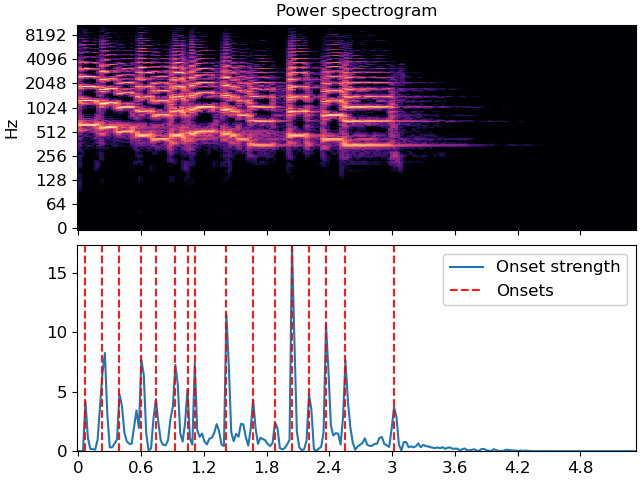librosa.onset.onset_detect
- librosa.onset.onset_detect(*, y=None, sr=22050, onset_envelope=None, hop_length=512, backtrack=False, energy=None, units='frames', normalize=True, sparse=True, **kwargs)[source]
Locate note onset events by picking peaks in an onset strength envelope.
The peak_pick parameters were chosen by large-scale hyper-parameter optimization over the dataset provided by [1].
- Parameters:
- ynp.ndarray [shape=(…, n)]
audio time-series. Multi-channel is supported.
- srnumber > 0 [scalar]
sampling rate of
y- onset_envelopenp.ndarray [shape=(…, m)]
(optional) pre-computed onset strength envelope
- hop_lengthint > 0 [scalar]
hop length (in samples)
- units{‘frames’, ‘samples’, ‘time’}
The units to encode detected onset events in. By default, ‘frames’ are used.
- backtrackbool
If
True, detected onset events are backtracked to the nearest preceding minimum ofenergy.This is primarily useful when using onsets as slice points for segmentation.
Note
backtracking is only supported if
sparse=True.- energynp.ndarray [shape=(m,)] (optional)
An energy function to use for backtracking detected onset events. If none is provided, then
onset_envelopeis used.- normalizebool
If
True(default), normalize the onset envelope to have minimum of 0 and maximum of 1 prior to detection. This is helpful for standardizing the parameters oflibrosa.util.peak_pick.Otherwise, the onset envelope is left unnormalized.
- sparsebool
If
True(default), detections are returned as an array of frames, samples, or time indices (as specified byunits=).If
False, detections are encoded as a dense boolean array whereonsets[n]is True if there’s an onset at frame indexn.Note
multi-channel input is only supported if
sparse=False.- **kwargsadditional keyword arguments
Additional parameters for peak picking.
See
librosa.util.peak_pickfor details.
- Returns:
- onsetsnp.ndarray [shape=(n_onsets,) or onset_envelope.shape]
estimated positions of detected onsets, in whichever units are specified. By default, frame indices.
If sparse=False, onsets[…, n] indicates an onset detection at frame index n.
Note
If no onset strength could be detected, onset_detect returns an empty array (sparse=True) or all-False array (sparse=False).
- Raises:
- ParameterError
if neither
ynoronsetsare providedor if
unitsis not one of ‘frames’, ‘samples’, or ‘time’
See also
onset_strengthcompute onset strength per-frame
onset_backtrackbacktracking onset events
librosa.util.peak_pickpick peaks from a time series
Examples
Get onset times from a signal
>>> y, sr = librosa.load(librosa.ex('trumpet')) >>> librosa.onset.onset_detect(y=y, sr=sr, units='time') array([0.07 , 0.232, 0.395, 0.604, 0.743, 0.929, 1.045, 1.115, 1.416, 1.672, 1.881, 2.043, 2.206, 2.368, 2.554, 3.019])
Or use a pre-computed onset envelope
>>> o_env = librosa.onset.onset_strength(y=y, sr=sr) >>> times = librosa.times_like(o_env, sr=sr) >>> onset_frames = librosa.onset.onset_detect(onset_envelope=o_env, sr=sr)
>>> import matplotlib.pyplot as plt >>> D = np.abs(librosa.stft(y)) >>> fig, ax = plt.subplots(nrows=2, sharex=True) >>> librosa.display.specshow(librosa.amplitude_to_db(D, ref=np.max), ... x_axis='time', y_axis='log', ax=ax[0], sr=sr) >>> ax[0].set(title='Power spectrogram') >>> ax[0].label_outer() >>> ax[1].plot(times, o_env, label='Onset strength') >>> ax[1].vlines(times[onset_frames], 0, o_env.max(), color='r', alpha=0.9, ... linestyle='--', label='Onsets') >>> ax[1].legend()
